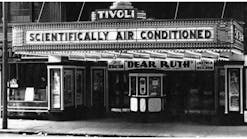In the world of facility management, no one can afford to be caught unprepared in the event of an emergency. Yet the uncertainty of today's economy is forcing many facility managers to tempt fate. Organizations of all sizes are under increasing pressure to cut capital expenses and focus on revenue-generating core competencies. As a result, substantial facility investments are being put on hold, with limited or aging equipment forced to operate for as long as possible in what commonly is referred to as "run-to-fail" mode. For facility managers in such predicaments, there is the cooling contingency plan, an affordable, flexible, and reliable way to prepare for the unexpected.
The cost of developing a cooling contingency plan is minimal compared with the cost of responding to an unplanned cooling failure. For example, in the wake of an emergency, running piping for a 500-ton backup system might cost as much as $5,000 to $20,000. As part of a contingency cooling plan, running that same piping can cost as much as 90-percent less.
Installing hydronic pipes and electrical connections are two measures you will want to take as part of a cooling contingency plan. To those ends:
- Determine how a temporary cooling system will tie into the entire infrastructure. Consider not only chilled-water piping, but electrical connections and, if applicable, the condenser-water system.
- Dedicate a chilled-water branch to the temporary cooling unit, including shutoff valves and pipe caps.
- Understand the electricity needs of a temporary cooling unit. For example, air-cooled chillers use twice as much power as water-cooled ones.
- Determine temporary-equipment locations, designate contact personnel, and identify on-site logistical issues.
Mapping details such as these in advance allows you to avoid the panic and overtime costs often associated with unplanned implementation of temporary cooling.
The top three considerations when designing a successful cooling contingency plan are:
- Site preparation. Long before the need arises, identify a location that will not only accommodate rental equipment, but provide access to required electrical and mechanical connections.
- Service and support. Include provisions for the commissioning, maintenance, and decommissioning of temporary cooling equipment.
- Supplier. When choosing a supplier, consider three factors: expertise, availability, and flexibility. Identify suppliers with in-depth knowledge of temporary cooling equipment. If overlooked, even the smallest of details can create major problems during a crisis.
Look for suppliers with experience in application engineering, project management, and service. By selecting a supplier with a wide range of capabilities, you can rest assured your cooling contingency plan will be comprehensive, including a needs assessment, site preparation, installation, setup, commissioning, controls integration, and ongoing maintenance.
When the need for temporary cooling arises, businesses cannot afford delays. Look for suppliers with newer-model, energy-efficient units available for quick delivery.
Lastly, look for a supplier flexible enough to customize rental agreements to meet specific needs.
Did you find this column useful? Send comments and suggestions to Executive Editor Scott Arnold at [email protected].
Michael McGraw is director of Johnson Controls Rental and Modular Solutions. He has been with York and Johnson Controls for nine years. Johnson Controls’ inventory of rental chillers is located throughout North America and serviced by more than 150 branch locations. For more information, visit www.johnsoncontrols.com/rental.
Not Just for Emergencies Anymore
Contingency plans based on temporary cooling are not just for emergencies anymore.
A cooling contingency plan can relieve some of the pressure of completing projects on or under budget. With a contingency plan involving temporary cooling, there is no more need to consider every "what-if" scenario. A permanent solution can be implemented to meet current requirements, with temporary cooling relied upon to meet future needs. The dollars saved up front can be channeled to other profit-generating activities. Hospitals can use the additional capital to add beds or improve patient comfort. Manufacturers can expand or add product lines. Schools can update facilities or increase capacity.
A backup plan involving temporary cooling delivers benefits throughout a facility's life cycle:
- During peak loads. When additional capacity is required only temporarily, perhaps as the result of a seasonal heat wave, natural disaster, or special event, a rental chiller allows businesses to conserve capital.
- When commissioning a permanent chiller. Rental chillers give businesses an opportunity to validate system requirements before purchasing new equipment. In this "try before you buy" scenario, companies may be able to rent the exact equipment slated for purchase. While new equipment is on order and being installed, a rental chiller allows operations to continue undisturbed.
- During the switch to a new chiller following failure. A rental chiller can provide redundancy cooling during restoration of a primary or backup system following failure. Redundancy cooling provides peace of mind in mission-critical environments, such as hospitals and data centers.
- When conducting routine maintenance. When a chiller is offline for routine maintenance, temporary cooling allows operations to continue uninterrupted.
Incorporating temporary cooling into a design tells clients you are thinking beyond today. You are considering their long-term needs. You are building in flexibility they might need tomorrow in a way that allows them to preserve capital and minimize risk today.
Devising a cooling contingency plan involves more than specifying temporary cooling equipment, however. A comprehensive plan must include a strategy for successful implementation of the temporary solution. What good is backup equipment if it cannot be installed seamlessly and maintained reliably?








